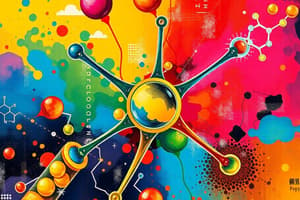Podcast
Questions and Answers
What defines the atomic number of an element?
What defines the atomic number of an element?
- The difference between protons and electrons
- The number of protons in the nucleus (correct)
- The number of neutrons in the nucleus
- The total number of protons plus neutrons
What is the charge of a cation?
What is the charge of a cation?
- Net positive (correct)
- Neutral
- Net negative
- Negative
Which of the following accurately describes isotopes?
Which of the following accurately describes isotopes?
- Isotopes vary in the number of neutrons (correct)
- Isotopes are always radioactive
- Isotopes have identical mass numbers
- Isotopes have different numbers of protons
What is the primary factor that determines the chemical behavior of an atom?
What is the primary factor that determines the chemical behavior of an atom?
How is the mass number of an atom calculated?
How is the mass number of an atom calculated?
Which statement about the periodic table is true?
Which statement about the periodic table is true?
What is the effect of beta decay on an isotope?
What is the effect of beta decay on an isotope?
What is meant by the term 'half-life'?
What is meant by the term 'half-life'?
Which element is NOT one of the six most common elements found in living organisms?
Which element is NOT one of the six most common elements found in living organisms?
What does the subscript in a molecular formula indicate?
What does the subscript in a molecular formula indicate?
Which of the following correctly describes a compound?
Which of the following correctly describes a compound?
What is primarily responsible for determining how an atom reacts with others?
What is primarily responsible for determining how an atom reacts with others?
Which statement best describes a mixture?
Which statement best describes a mixture?
In the context of chemical reactions, what are reactants?
In the context of chemical reactions, what are reactants?
Which rule dictates that atoms prefer to have paired electrons in their outermost orbit?
Which rule dictates that atoms prefer to have paired electrons in their outermost orbit?
What type of molecules are carbon-free but still vital to the structure of organisms?
What type of molecules are carbon-free but still vital to the structure of organisms?
Flashcards are hidden until you start studying
Study Notes
Properties of Matter, Atoms, and Elements
- Matter is defined as anything that occupies space and has mass.
- Atoms are the smallest complete units of matter; they consist of subunits and are fundamental to all substances.
- Energy can also be categorized as a form of matter.
- Chemistry is the scientific study focused on the composition, properties, and reactions of matter.
Atomic Structure
- Atoms are composed of three subatomic particles: protons, neutrons, and electrons.
- Atoms consist of two regions: the nucleus (containing protons and neutrons) and clouds/orbitals/shells (where electrons reside).
- Protons are positively charged with a mass of 1 atomic mass unit (AMU); neutrons are neutral with the same mass.
- Electrons have a negative charge and negligible mass.
- Definitions: Mass is the amount of material, while weight is the gravitational force on that mass.
Properties of Subatomic Particles
- Atoms are electrically neutral, meaning the number of protons equals the number of electrons.
- The atomic number, determined by the number of protons, defines the element.
- An element cannot be broken down into simpler substances by ordinary chemical means.
- Mass number is the sum of protons and neutrons; variations in mass arise from isotopes, which differ in neutron count.
- Isotopes can be classified as light (fewer neutrons), heavy (more neutrons), or radioactive (decaying over time).
- Half-life represents the time it takes for half of a sample to decay; e.g., Carbon-14 has a half-life of 5,600 years.
- Ions arise when electrons do not equal protons, resulting in charged particles (cations and anions).
Atomic Properties and Periodic Table
- The periodic table, developed by Dmitri Mendeleev and Lothar Meyer, organizes elements by atomic number and mass.
- Elements are arranged in columns (groups) with similar electron configurations and in rows (periods) by increasing atomic number.
- The behavior of an atom is largely influenced by its electron arrangement in orbitals, which are 3D probability zones.
Key Elements in Biology (SPONCH)
- Living organisms primarily use six elements:
- Carbon, Oxygen, Nitrogen, Hydrogen, Phosphorus, Sulfur.
- Trace elements are present in smaller amounts but are also essential for life.
Chemistry of Life
- Inorganic molecules do not contain carbon but can be vital for organism structure and function.
- Organic molecules contain carbon and typically include hydrogen, oxygen, or nitrogen.
- Compounds consist of molecules made up of two or more different elements, while mixtures are combinations without bonding.
Chemical Bonds and Reactions
- Chemical bonds are forces that hold atoms together through electron interactions.
- Molecules consist of two or more atoms bonded chemically; compounds have fixed proportions, whereas mixtures do not.
- Electrons dictate chemical bonding; their arrangement and availability influence atomic reactivity.
- The octet rule states that atoms prefer to have paired electrons in their orbitals, with eight electrons in the outermost shell when possible.
- Chemical reactions involve the formation or breaking of bonds, with reactants transforming into products without changing atomic identity.
- Reaction extent can be influenced by temperature, concentration, and catalysts, and many reactions can be reversible.
Studying That Suits You
Use AI to generate personalized quizzes and flashcards to suit your learning preferences.




